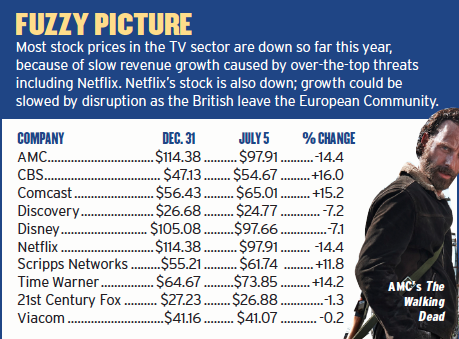TV Business Getting Poor Reception on Wall Street

The TV business is getting a lot of static from Wall Street lately. As companies get ready to report second-quarter earnings later this month, several economic and technological trends are making the profit picture fuzzy for an industry that long delivered predictable revenue growth and enviable margins.
The market assumes the over-the-top threat led by Netflix will eat traditional TV’s lunch. As consumers cut the cord, subscriber revenues from cable, satellite and telco distributors will fall as people stop spending money on pay TV and get their entertainment the cool way, via streaming. A steady drumbeat of reports from Nielsen and others show how subscriber totals are slowly eroding away.
At the same time, TV’s other key revenue stream, advertising, seems stuck in neutral at best. Advertisers are enamored of digital advertising. Some of the ad dollars marketers and advertisers have lavished on digital has returned to TV in the short term, network sales executives say, but competing with digital remains a formidable challenge.
Even the British vote to exit the European Union makes life more difficult for media companies looking for growth beyond the mature U.S. market. High-flying Netflix was downgraded by Needham & Co. analyst Laura Martin from ‘buy’ to ‘hold’ because of Brexit.
To fight back, TV is trying to become more like online media. Networks are cutting commercial loads, building data and analytics capabilities and increasing the amount of branded content they do. It’s unclear this will work. During the nearly done upfront for the 2016-17 broadcast season, the market was strong. Volume was up 3%-5% and price increases topped double digits for many networks. But the math doesn’t add up to a big boost in revenue. Todd Juenger of Sanford C. Bernstein calculated that with a 10% increase in prices, broadcast network ad revenue would be up 2% next year, while cable network revenue could fall 6%.
The latest gloomy report came from Moody’s Investor Service on June 29. In it, Moody’s senior VP Neil Begley talks colorfully about TV’s coming day of reckoning, the OTT barbarians at the gate, that broad systemic change is necessary and that the monumental task of restructuring the business will be difficult for a fragmented industry.
“Media companies have not sufficiently embraced advances in technology and consumption preferences, clearly ignoring reality and only slowly and individually entering new distribution relationships. This path is certain to gradually erode the widely distributed and very stable pay-TV bundle and its escalating contractual revenue stream of subscriber fees revenues,” Begley said.
The smarter way to stay on top of broadcasting and cable industry. Sign up below

Begley makes a few modest suggestions, such as ending the linear distribution models; offering all programming on-demand with full stacking rights; implementing robust search and recommendation interfaces; and offering real-time targeted ad placement focused on the viewer instead of the program.
“The barriers to this dream scenario are great. They include getting all the major producers, network owners and [multichannel video programming distributors] to agree on standards in an industry that has trouble agreeing on anything,”
Begley said. “However, we do not expect that leadership and consensus to materialize and, therefore, we believe that there is well under 50% probability that revolutionary change such as what is suggested above will occur.” Begley is hardly the only TV bear. Rich Greenfield of BTIG, who gleefully predicts the industry’s downfall online with the hashtag #GoodLuckTV, wrote about a recent trip to Walmart, where shoppers were getting advice on how to cut the cord. Amazon is also aggressively pushing OTT services, including Amazon Prime Video, to its customers.
“While we still expect the vast majority of U.S. households to continue subscribing to a big bundle of channels, we have to believe the antenna/ streaming synthetic bundles being pitched by Walmart and Amazon are of interest to at least 15-20 million U.S. households,” Greenfield said. “That raises the question, does any broadcast or cable network have a growth strategy if they lose 15% of their subscriber base in the next 5+ years?”
And Bernstein’s Juenger published a report July 1 on the industry entitled, ominously, “First We Take Your Audience, Then We Take Your Revenue, Then We Take Your People.” He asks who will run media companies in their declining years—an important question for investors. “The young talent, especially the creative talent, all seems to be fleeing ‘old media’ for the digital world,” he said.
Outside of Disney, where a search is on for a successor to CEO Bob Iger, “we find it somewhat amazing there’s no talk about succession at any of the other companies,” he said.
Jon has been business editor of Broadcasting+Cable since 2010. He focuses on revenue-generating activities, including advertising and distribution, as well as executive intrigue and merger and acquisition activity. Just about any story is fair game, if a dollar sign can make its way into the article. Before B+C, Jon covered the industry for TVWeek, Cable World, Electronic Media, Advertising Age and The New York Post. A native New Yorker, Jon is hiding in plain sight in the suburbs of Chicago.

